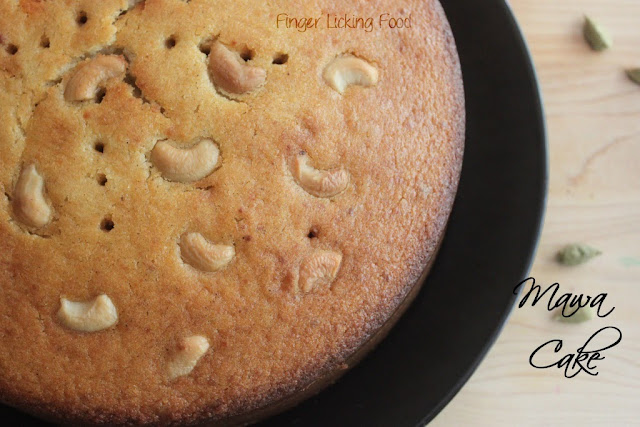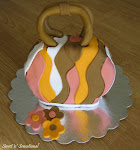This month's challenge for the Daring Bakers was just perfect to cool off the heat this past week. A chilled super moist cake soaked in a mixture of sweetness layered with fruit and whipped cream...mmm..! Sound familiar?
"Inma of la Galletika
was our Sept. 2013 Daring Bakers’ hostess and WOW did she bring us
something decadent and delicious! Pastel de Tres Leches or Three Milk
Cake, creamy yet airy, super moist but not soggy.. just plain delish!"
I've made Tres Leches before so this wasn't so much of a challenge for me. What was different however, was the fact that this was a free-standing layered Tres Leches as opposed to the Tres Leches I've always made which is a cake soaked in a pan. I never had to worry about how well the cake was soaked or if it would make a huge mess by oozing out the excess milk mixture. So this, I really wanted to try.
Recipe Source: This recipe is slightly adapted
from an interview given by one of Mexico's best Pastry Chefs; Paulina
Abascal to the magazine Revista Secretos de la Pastelería Caserais. It
produces a super moist, yet light Tres Leches.
Mandatory Items: You have to make 1 three milks cake.
I was waiting all month for a reason to make the Tres Leches.I didn't want to land up eating all of it myself :) I'm taking this to dinner to a friend's place tonight.
Preparation time: 1 hour and a half
Equipment required:
• A scale for measuring all ingredients
• Some bowls
• Stand mixer
• Strainer to sift the flour
• Egg Whisk
• Square Cake pan 9”x9” (23cmx23 cm) or 9” (23 cm) round cake pan
• Saucepan
• Pastry brush
• Pastry Spatula
• A scale for measuring all ingredients
• Some bowls
• Stand mixer
• Strainer to sift the flour
• Egg Whisk
• Square Cake pan 9”x9” (23cmx23 cm) or 9” (23 cm) round cake pan
• Saucepan
• Pastry brush
• Pastry Spatula
Classic Three Milks Cake:
Servings: 12
You will need:
For the Sponge Cake:
5 large eggs at room temp (separated)
½ cup (120 ml) (4 oz) (125 gm) sugar
2 teaspoons (10 ml) of vanilla extract
1 cup (240 ml) (5 oz) (140gm) all-purpose (plain) flour (sifted)
½ cup (120 ml) (4 oz) (125 gm) sugar
2 teaspoons (10 ml) of vanilla extract
1 cup (240 ml) (5 oz) (140gm) all-purpose (plain) flour (sifted)
For three milks syrup:
1 can (14 oz) (400 gm) sweetened condensed milk
1 can (12 oz) (340 gm) evaporated milk
1 cup (240 ml) heavy cream (about 35% fat) or 1 cup of half & half or 1 cup milk
1 cinnamon stick
2 teaspoons (10 ml) rum (or other flavoring)
1 can (14 oz) (400 gm) sweetened condensed milk
1 can (12 oz) (340 gm) evaporated milk
1 cup (240 ml) heavy cream (about 35% fat) or 1 cup of half & half or 1 cup milk
1 cinnamon stick
2 teaspoons (10 ml) rum (or other flavoring)
Topping and filling:
2 cups (500 ml) of whipping cream (about 30% fat)
½ cup (120 ml) (4 oz) (125 gm) sugar
Canned or fresh fruit (to fill and decorate the cake)
2 cups (500 ml) of whipping cream (about 30% fat)
½ cup (120 ml) (4 oz) (125 gm) sugar
Canned or fresh fruit (to fill and decorate the cake)
Directions For the Sponge Cake:
- Preheat oven to moderate 180°C/350°F/gas mark 4. Prepare a square 9”x9” (23cmx23 cm) pan or 9” (23 cm) round cake pan by greasing with butter and dusting with flour.
- Separate the egg whites from the yolks.
- Beat the egg whites on medium speed, 3 - 5 minutes.
- When soft peaks form slowly add the sugar in small batches.
- Whip until stiff peaks form about 5 minutes. Set aside.
- In a medium bowl beat egg yolks at medium-high speed for about 5 to 6 minutes, or until the egg yolks become pale colored, creamy and puffy. Stir in vanilla.
- Pour the egg yolks over the egg whites, gently fold until just combined trying not to lose any volume from the mixture.
- Fold in the flour little by little in the form of rain. Mix until just combined (over-beating will result in a denser, flatter cake).
- Pour the batter into the prepared 9”x9” (23cmx23 cm) square cake pan or 9” (23 cm) round cake pan.
- Bake in the preheated moderate oven for 25 minutes or until the toothpick comes out clean
- Cool for 10 minutes in the pan and then let it cool completely on a wire rack.
Once cool, split the cake in half, flip the top of the cake and
place it on a base. Using a fork, poke holes on the cake to help absorb the milk syrup.
In a saucepan add the sweetened condensed milk, evaporated milk, heavy
cream and cinnamon stick, bring to a boil, reduce the heat and continue
boiling for 5 minutes. Remove it and let it cool.
Once it is cool, add the rum or any other flavoring you choose to use. I used Vanilla extract.
Gradually brush all the milk soaking liquid into all sides of the
cake (including the cut surfaces) until all absorbed. I brushed the cake with the milk mixture and waited 5 minutes to let it absorb, then brushed it again. This ensured the cake soaked up the liquid well.
Whip the cream with the sugar until stiff peaks form. Spread 1/3 of the cream on one half of the soaked cake. Spread evenly using an offset spatula. Top with your favorite fruit. I used canned, drained pineapple chunks and mandarin oranges.
Slowly transfer top half of soaked cake onto the bottom half, soak with remaining liquid if any. Use remaining cream to frost the entire cake with a spatula. Decorate the top with more fruit.
Let chill overnight which allows the cake to soak up all the liquid well and also a chilled Tres Leches tastes far better than one that isn't!
Delicious fruit on a super delicious cake.. I had no trouble finishing an extra large slice! Thanks to Inma, for giving me a chance to make this crowd pleasing dessert again.



























